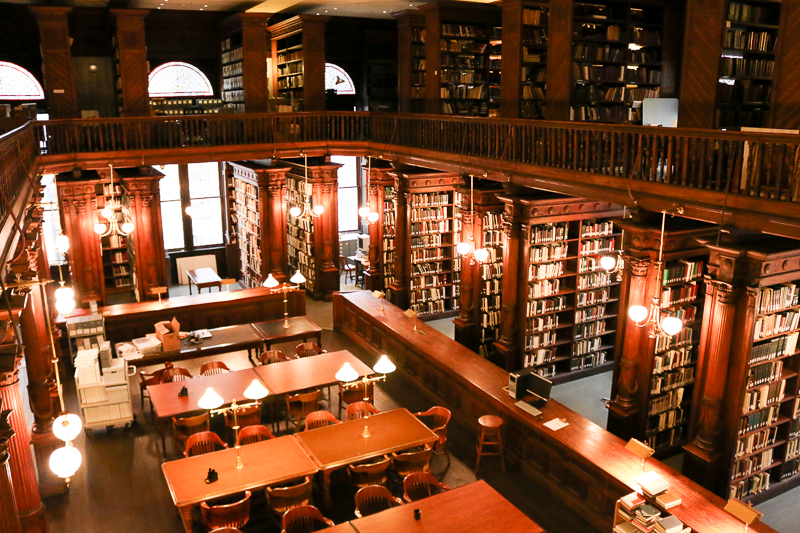brooklyn historical society
space type: museum, nonprofit | neighborhood: brooklyn heights | active since: 1863 | links: website, facebook, twitter
The Brooklyn Historical Society is definitely a bit more conventional than the spaces I usually cover here. But this is a site about exploring everything our borough has to offer, and that doesn’t only mean watching aerialists in a Bushwick loft or riding flaming bicycles in a Bed-Stuy alleyway. And it should also go without saying that Brooklyn is absolutely steeped in history, and that the particular initiatives, accidents, and cultural tides of the past are in large part responsible for making the present what it is.
BHS is a beautiful way to connect with all that. As Programs Associate Meredith Duncan told me, “Sharing the past is so important because it informs what’s happening in the present, and also what will happen to the future communities and culture of Brooklyn.”
Founded in 1863 as the Long Island Historical Society, BHS’s mission is to “make the vibrant history of Brooklyn tangible, relevant, and meaningful for today’s diverse communities, and for generations to come.” The gorgeous building, which turns 150 this year, is best known for its stunning two-floor research library. But after finishing a $5.5 million renovation, the space now features a lot more: four art galleries, an event space for public programming, a classroom for student workshops, and a gift shop filled with crafts from a wide variety of Brooklyn makers.
The four galleries cover a lot of different ground: currently on exhibit upstairs is “Documenting Sandy,” a collection of mostly cellphone pix from the harrowing superstorm and its aftermath; whereas the just-opened exhibit on the main level, “In Pursuit of Freedom,” is a public history project exploring the heroes of Brooklyn’s anti-slavery movement.
The public programming offered at BHS is extremely diverse as well. Some of this year’s fascinating events include: Pat Kiernan in conversation with Gothamist publisher Jake Dobkin, an original musical by the Irondale Ensemble called Color Between the Lines, a lecture on the history of the Gowanus Canal by popular Brooklyn Brainery speaker Joseph Alexiou, a walking tour of the Wallabout Historic District, and the Brooklyn Zine Fest—just to name a few.
And then, of course, there’s the nationally recognized Othmer Library. Its various collections include municipal and administrative records from the villages that eventually became Brooklyn, personal and family papers dating back to the 1600s, genealogies, war histories, several thousand prints and drawings from the 17th century on, and more than 300 oral history narratives. There’s also a photography collection that starts in the 1870s, which includes amateur and professional photographs of buildings, people, and major cultural events, from the building of the Brooklyn Bridge to the 1977 Bushwick blackout. And there’s a large collection of cultural ephemera relating to Brooklyn icons, from the Wonderwheel to the Dodgers.
There’s even a whole room dedicated to maps, as well as a person whose entire job is to catalogue and classify them. The amount of history contained in these maps alone is staggering; in addition to extensive street and lot maps, there are centuries-old Fire Department maps, municipal maps, sewage system maps, transit maps, and on and on. It’s exhilarating to look through them and feel the power of history’s force under your fingertips.
The majority of the collections are available for public use, although you need to make an appointment to view some of it. There are also various online-accessible catalogues—but don’t skip a visit to the marvelous building if you can help it.
You should definitely visit to see for yourself the incredible resources available throughout BHS. In the meantime, sign up for the newsletter, where you’ll get to see Photo of the Week and a Map of the Month taken from the archives. BHS also publishes books, curriculum kits, and neighborhood guides, from Greenpoint to Bay Ridge, some with accompanying walking tours and podcasts.
According to Meredith, some of BHS’s future goals are “to encourage more interaction with the greater Brooklyn community, and to become a cultural hub, both for Brooklynites and for tourists.” In addition, they’re hoping increase educational initiatives; through donations and grants, schoolchildren can visit for free, so they’re working on expanding outreach to teachers who could take advantage. BHS also works with university professors to help them use original artifacts in their classes. And of course, BHS will continue to be a resource for anyone who, for any reason at all, wants to learn more about amazing Brooklyn.
***
Like this? Read about more historic spaces: South Oxford Space, Brooklyn Lyceum, The Schoolhouse, Broken Angel


















